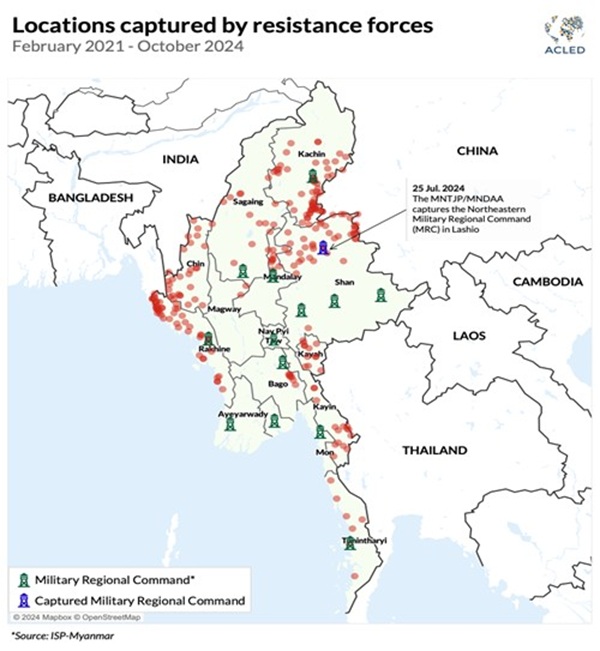The ongoing conflict in Myanmar is becoming increasingly complex, with concerns that it may 'risk becoming a forgotten crisis’ warned Julie Bishop, Special Envoy of the UN Secretary-General for Myanmar. The successes by the Three Brotherhood Alliance (3BHA), since Operation 1027, have exposed significant vulnerabilities within the military, including significant territorial losses, low morale and recruitment struggles. Even attempts to recapture a critical intersection have faced strong resistance from ethnic groups.
Changing Power Dynamics Shift in Myanmar
In the beginning of the year 2024, the military extended the state of emergency beyond its constitutional limit. Senior General Min Aung Hlaing, Chairman of the State Administration Council, emphasised the government's vision to conduct a free and fair elections to hand over State responsibilities to the winning party. But the regime's plans raise concerns about transparency and inclusivity.
The coordinated efforts of PDFs, LDFs, and EAOs have significantly altered the battlefield dynamics in Myanmar, putting the military on the defensive and demonstrating the growing strength and resilience of the resistance movement. The capture of 80 towns and 200 military bases demonstrates the growing strength and influence of the resistance.[1] More importantly, the capture of a key regional military command in Lashio signifies a major setback for the Myanmar military.

The AA's military gains in Rakhine State have significantly altered the power dynamics in Myanmar, with potential implications for regional security and India's strategic interests. In late 2024, the Arakan Army (AA), significantly escalated its conflict with the Myanmar military. The AA seized the last Myanmar military outpost, BGP-5 in northern Rakhine State, gaining full control of the border with Bangladesh. Earlier, the Myanmar National Democratic Alliance Army (MNDAA) had captured a regional command headquarters in northeastern Myanmar. And similarly, many other ethnic armies are gaining control over the territories and ruling them.
The Price of Instability
Ongoing fighting has resulted in civilian casualties and displacement. Over 5,350 civilians have been killed, and more than 3.3 million people have been displaced. [2] The violence perpetrated by the military has plunged over half the population into poverty. This crisis disproportionately affects children, with 6 million facing worsening conditions and over 33% of the internally displaced population comprising children. [3] Additionally, Myanmar's economy is facing a severe crisis, with the World Bank projecting a 1% GDP contraction for the fiscal year ending March 2025. [4] With over half of the country's townships are embroiled in active conflict, critical supply chains are disrupted, border trade crippled, and domestic demand severely impacted.
The situation has been further exacerbated by natural disasters. Typhoon Yagi and heavy monsoon rains have caused widespread flooding, affected millions of people and damaged vital infrastructure. Agricultural production has been severely disrupted, with more than half of agricultural firms reporting significant losses. This has led to a surge in food prices and heightened food insecurity among vulnerable populations. Households are struggling to cope with rising prices and a weakened labour market. Many are facing increasing economic hardship and food insecurity. Migration has emerged as a crucial survival strategy for many Myanmar citizens. However, much of this migration occurs through informal and often dangerous channels, increasing the risks and reducing the potential benefits for migrants.
Limited International Support
The international community faces challenges in providing humanitarian assistance and supporting peace efforts. The United States through its BURMA Act aimed to engage with Myanmar resistance groups like the NUG and provide non-lethal assistance. However, its implementation has been slow. In August 2024, the officials from US including, State Department Counsellor Tom Sullivan, held a meeting with key members of Myanmar's pro-democracy movement, including the National Unity Government and several ethnic armed organizations. The meeting reaffirmed the shared goal of maintaining pressure on the Myanmar military to change its course and restore democracy. The US also engaged with allies like Canada, the UK, EU, and Quad countries, as well as ASEAN. Additionally, the US and many western nations imposed targeted sanctions on the military leaders and companies to restrict the military's revenue and access to vital supplies.
China's Double-Edged Sword
China wields considerable influence in Myanmar due to its geographical proximity, economic interests, and deep-rooted relationships with various actors, including the military, ethnic armed groups, and the pro-democracy movement. China employs a “double-game” approach, engaging with both the military and the resistance simultaneously and pursuing its economic and strategic interests. Since Operation 1027, China pressured both sides towards a ceasefire but failed. Initially, China supported Myanmar’s military junta, primarily for border security reasons. The arrest of the MNDAA leader, though the authorities disagreed, was to woo the military leaders. In November 2024, General Min Aung Hlaing, visited China and met Chinese officials in Kunming. Min Aung Hlaing reiterated his intention to restart peace talks with ethnic groups, but under conditions that they show genuine commitment to peace. China reaffirmed its backing for the junta’s political roadmap and the China-Myanmar Economic Corridor, driven by its strategic goal to secure vital infrastructure, access to the Indian Ocean, and control over Myanmar’s natural resources. However, the escalating violence in Myanmar has led China to reassess its position. The October attack on the Chinese consulate in Mandalay suggests the attack signals public frustration with China’s support for the military regime.
ASEAN and Divisions Within
The Myanmar crisis has exposed deep divisions within ASEAN, reflecting broader geopolitical tensions. The Five Point Consensus (FPC), while well-intentioned, has proven ineffective in stemming violence or fostering dialogue in Myanmar. The role of the ASEAN Special Envoy is limited by factors such as short tenures, lack of independence, and the prevailing political climate within ASEAN. Laos' chairmanship too failed to bring all the stakeholders together. The regional meetings held in December 2024 in Thailand aimed to hold informal consultations with the military as well as neighbouring countries. Though detailed discussions were held, but failed to arrive at a conclusion. Earlier in June 2024, Cambodia actively advocated for dialogue through the "Phnom Penh Peace Process”.
Implications for India
India's Myanmar policy is characterized by a cautious approach that seeks to balance its security and economic interests and the implementation of its Act East Policy as well as countering closer ties between Myanmar and China. India maintains engagement with the military as evident from India's External Affairs Minister, S. Jaishankar, meeting Myanmar's Deputy Prime Minister and Foreign Minister, Than Shwe, in New Delhi, marking the first high-level dialogue between India and Myanmar's military regime since the 2021 coup. Jaishankar stressed the importance of ensuring security for Indian projects in Myanmar, including the Kaladan multimodal transport project, and called for Myanmar to transition back to democratic governance.
Simultaneously, India started a benign engagement with the opposition forces, including the NUG and a few ethnic armed groups bordering India. The growing power of ethnic armed groups and the weakening of the Myanmar military pose challenges to regional stability and India's strategic interests. This dual approach reflects India's attempt to balance its security and economic interests with its concerns about the human rights situation and the democratic aspirations of the Myanmar people.
At the beginning of the year, the Government of India announced its decision to suspend the Free Movement Regime (FMR) on the India-Myanmar border due to continued challenges from insurgent groups smuggling arms and drugs as well as illegal movement across the porous boundary. But by December 2024, the Union Ministry of Home Affairs introduced a new protocol to control the movement of people living within 10 kilometres on either side of the largely unfenced international border. As per the new guidelines, individuals crossing from India to Myanmar will be issued a "border pass" by the Assam Rifles, allowing them to stay in Myanmar for up to seven days.
Prognosis for 2025
2025 is likely to be another year of protracted conflict in Myanmar, with no clear path towards a resolution. While the military regime appears to be losing ground militarily, it remains firmly entrenched in the central areas with key control over vital resources and therefore, unlikely to be completely ousted. While the NUG and EAOs are making gains, they lack the capacity for a decisive victory and face challenges in establishing a unified front and a stable governance structure. The risk of Myanmar fragmenting into de facto autonomous regions controlled by different armed groups is significant. Further, the military's planned elections are unlikely to be free and fair and are unlikely to be recognized by the international community.
While the international community will have little influence in the region, China's will continue to be a major factor. India and other regional powers will also play a role, albeit with limited leverage. With Malaysia taking over as the chair of ASEAN, there is hope that there could be possible thaw in initiating a dialogue between the two sides. But the most likely scenario is a continuation of the current conflict with no clear winner. Repeated ceasefire violations demonstrate the difficulty of achieving lasting peace. This could lead to a protracted period of instability and suffering for the Myanmar people.
Policy Recommendations for India
First, India must enhance its engagement with a broader spectrum of actors, including the NUG, key EAOs, and local communities, particularly in border areas. The central government could utilize the connections of Northeast Indian states with their counterparts in Myanmar to foster understanding and promote regional cooperation. To diffuse the crisis, it is important to encourage and support all efforts towards an inclusive political solution, including dialogue between the military, the NUG, and EAOs.
Second, India must reassess the need for extensive border fencing. The recent initiative to regulate border crossings is a step in the right direction. To balance security needs, India could consider alternative measures like temporary fencing and enhanced surveillance technologies. Third, India has repeatedly emphasized the ASEAN-led Five-Point Consensus as the framework for resolving the crisis. But simultaneously India acknowledges the importance of a Myanmar-led solution, with ASEAN and neighbouring countries playing a facilitating role. Finally, India must also shift focus of development assistance towards empowering local communities and building resilience. By implementing these recommendations, India can play a more constructive role in addressing the Myanmar crisis, safeguarding its own national interests, and promoting peace and stability in the region.
References
[1] https://acleddata.com/2024/11/26/between-cooperation-and-competition-the-struggle-of-resistance-groups-in-myanmar/#
[2] https://news.un.org/en/story/2024/09/1154436
[3] https://www.unicef.org/myanmar/stories/Myanmar-in-2024-eng
[4] https://www.worldbank.org/en/news/press-release/2024/12/11/compounding-crises-hit-myanmar-s-economy-and-its-people
(The paper is the author’s individual scholastic articulation. The author certifies that the article/paper is original in content, unpublished and it has not been submitted for publication/web upload elsewhere, and that the facts and figures quoted are duly referenced, as needed, and are believed to be correct). (The paper does not necessarily represent the organisational stance... More >>
Image Source: https://en.wikipedia.org/wiki/File:Flag_of_Myanmar_Border_Guard_Forces.png










Post new comment